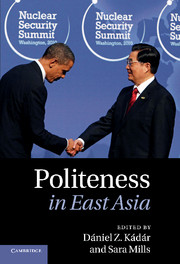1 - Introduction
Published online by Cambridge University Press: 07 September 2011
Summary
Introduction
Since the first encounters between East Asian people and Westerners, politeness has been treated as a salient issue. For example, the Venetian traveller Marco Polo (1254–1324) in his travelogue praised the Chinese with the following words:
The inhabitants of Cathay Province [that is China] are blessed with more beautiful and refined manners than others, because they continuously polish their minds with erudite studies. The common people talk in a refined style. They greet each other with gentle politeness, and they are very ceremonious. They behave with dignity like gentlemen, and they consume their meals very neatly. (The Travels of Marco Polo, ch. 34, cited in Kádár, 2007a: 2)
Furthermore, in many East Asian societies politeness was, and often still is, regarded as a ‘national treasure’. For example, in historical China the notion of li lit. ‘rite’, which includes both linguistic and non-linguistic behaviour, as well as religious rites (see Pan and Kádár, 2011a), was considered as a cultural heritage of the ancient sages, which differentiated the Chinese from the surrounding ‘barbarians’. In so far as the latter wanted to be ‘civilised’ (laihua 來華, lit. ‘come to China’, i.e. ‘Sinicised’) they were meant to learn the Chinese ways of etiquette (cf. Dikötter, 1992: 2). In a somewhat similar manner, as also argued by Pizziconi (see Chapter 3 in the present volume), in Japan the notion of keigo 敬語 lit. ‘deferential language’ was regarded as a defining feature that distinguished Japanese culture from other – ‘inferior’ – cultures.
In sum, politeness is a stereotypically salient characteristic of the languages and cultures of the East Asian region. Furthermore, in a similar way to major Western civilisations, in ‘civilised’ i.e. non-nomadic East Asian societies such as the Chinese and the Japanese, politeness was – and often continues to be – a pivotal component of national identity formation. For example, as Sinor's (1990: 17–18) authoritative study notes, Western thinkers such as Salvianus of Marseille (c. the fifth century, his exact dates are unknown) and Albert Magnus (c. 1200 – c. 1280) and the Chinese Classics describe the difference between ‘civilised people’, i.e. those who know ‘proper behaviour’, and ‘barbarians’, usually nomadic people, in remarkably similar ways.
- Type
- Chapter
- Information
- Politeness in East Asia , pp. 1 - 18Publisher: Cambridge University PressPrint publication year: 2011
- 11
- Cited by

